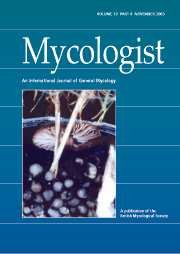Crossref Citations
This article has been cited by the following publications. This list is generated based on data provided by
Crossref.
Pinto, Eugénia
Afonso, Carlos
Duarte, Serafim
Vale-Silva, Luís
Costa, Elisangela
Sousa, Emília
and
Pinto, Madalena
2011.
Antifungal Activity of Xanthones: Evaluation of their Effect on Ergosterol Biosynthesis by High-performance Liquid Chromatography.
Chemical Biology & Drug Design,
Vol. 77,
Issue. 3,
p.
212.
Kathiravan, Muthu K
Salake, Amol B
Chothe, Aparna S
Dudhe, Prashik B
Watode, Rahul P
Mukta, Maheshwar S
and
Gadhwe, Sandeep
2012.
The biology and chemistry of antifungal agents: A review.
Bioorganic & Medicinal Chemistry,
Vol. 20,
Issue. 19,
p.
5678.
Ayati, Adile
Falahati, Mehraban
Irannejad, Hamid
and
Emami, Saeed
2012.
Synthesis, in vitro antifungal evaluation and in silico study of 3-azolyl-4-chromanone phenylhydrazones.
DARU Journal of Pharmaceutical Sciences,
Vol. 20,
Issue. 1,
Galante, Rafaela S.
Taranto, Alex G.
Koblitz, Maria G.B.
Góes-Neto, Aristóteles
Pirovani, Carlos P.
Cascardo, Júlio C.M.
Cruz, Sandra H.
Pereira, Gonçalo A.G.
and
Assis, Sandra A. de
2012.
Purification, characterization and structural determination of chitinases produced by Moniliophthora perniciosa.
Anais da Academia Brasileira de Ciências,
Vol. 84,
Issue. 2,
p.
469.
Kathwate, Gunderao Hanumantrao
and
Karuppayil, S. Mohan
2013.
Antifungal properties of the anti-hypertensive drug: Aliskiren.
Archives of Oral Biology,
Vol. 58,
Issue. 9,
p.
1109.
Negri, Melyssa
Salci, Tânia
Shinobu-Mesquita, Cristiane
Capoci, Isis
Svidzinski, Terezinha
and
Kioshima, Erika
2014.
Early State Research on Antifungal Natural Products.
Molecules,
Vol. 19,
Issue. 3,
p.
2925.
Castelli, María Victoria
Butassi, Estefanía
Monteiro, María Candida
Svetaz, Laura A
Vicente, Francisca
and
Zacchino, Susana A
2014.
Novel antifungal agents: a patent review (2011 – present).
Expert Opinion on Therapeutic Patents,
Vol. 24,
Issue. 3,
p.
323.
Bianchini, Luiz F.
Arruda, Maria F. C.
Vieira, Sergio R.
Campelo, Patrícia M. S.
Grégio, Ana M. T.
and
Rosa, Edvaldo A. R.
2015.
Microbial Biotransformation to Obtain New Antifungals.
Frontiers in Microbiology,
Vol. 6,
Issue. ,
Spolidorio, Denise M. Palomari
Francisconi, Renata Serignoli
Spolidorio, Luís Carlos
and
Rosa, Edvaldo Antonio Ribeiro
2015.
Oral Candidosis.
p.
21.
Filipuzzi, Ireos
Cotesta, Simona
Perruccio, Francesca
Knapp, Britta
Fu, Yue
Studer, Christian
Pries, Verena
Riedl, Ralph
Helliwell, Stephen B.
Petrovic, Katarina T.
Movva, N. Rao
Sanglard, Dominique
Tao, Jianshi
Hoepfner, Dominic
and
Alspaugh, J. Andrew
2016.
High-Resolution Genetics Identifies the Lipid Transfer Protein Sec14p as Target for Antifungal Ergolines.
PLOS Genetics,
Vol. 12,
Issue. 11,
p.
e1006374.
Koul, Mytre
and
Singh, Shashank
2017.
Penicillium spp..
Anti-Cancer Drugs,
Vol. 28,
Issue. 1,
p.
11.
Victoria Castelli, María
Gabriel Derita, Marcos
and
Noelí López, Silvia
2017.
Novel antifungal agents: a patent review (2013 - present).
Expert Opinion on Therapeutic Patents,
Vol. 27,
Issue. 4,
p.
415.
Illicachi, Luis
Montalvo-Acosta, Joel
Insuasty, Alberto
Quiroga, Jairo
Abonia, Rodrigo
Sortino, Maximiliano
Zacchino, Susana
and
Insuasty, Braulio
2017.
Synthesis and DFT Calculations of Novel Vanillin-Chalcones and Their 3-Aryl-5-(4-(2-(dimethylamino)-ethoxy)-3-methoxyphenyl)-4,5-dihydro-1H-pyrazole-1-carbaldehyde Derivatives as Antifungal Agents.
Molecules,
Vol. 22,
Issue. 9,
p.
1476.
Campoy, Sonia
and
Adrio, José L.
2017.
Antifungals.
Biochemical Pharmacology,
Vol. 133,
Issue. ,
p.
86.
Mlynarczyk, Dariusz T.
Dlugaszewska, Jolanta
Kaluzna-Mlynarczyk, Agata
and
Goslinski, Tomasz
2021.
Dendrimers against fungi – A state of the art review.
Journal of Controlled Release,
Vol. 330,
Issue. ,
p.
599.
Kathwate, Gunderao Hanumantrao
Shinde, Ravikumar Bapurao
and
Mohan Karuppayil, S.
2021.
Non-antifungal drugs inhibit growth, morphogenesis and biofilm formation in Candida albicans.
The Journal of Antibiotics,
Vol. 74,
Issue. 5,
p.
346.
Wind, Lauren L.
Briganti, Jonathan S.
Brown, Anne M.
Neher, Timothy P.
Davis, Meghan F.
Durso, Lisa M.
Spicer, Tanner
and
Lansing, Stephanie
2021.
Finding What Is Inaccessible: Antimicrobial Resistance Language Use among the One Health Domains.
Antibiotics,
Vol. 10,
Issue. 4,
p.
385.
Farinella, Victor F.
Kawafune, Eunizinis S.
Tangerina, Marcelo M. P.
Domingos, Helori V.
Costa-Lotufo, Leticia V.
and
Ferreira, Marcelo J. P.
2021.
OSMAC Strategy Integrated with Molecular Networking for Accessing Griseofulvin Derivatives from Endophytic Fungi of Moquiniastrum polymorphum (Asteraceae).
Molecules,
Vol. 26,
Issue. 23,
p.
7316.
Siswina, Tessa
Miranti Rustama, Mia
Sumiarsa, Dadan
and
Kurnia, Dikdik
2022.
Phytochemical profiling of Piper crocatum and its antifungal activity as Lanosterol 14 alpha demethylase CYP51 inhibitor: a review.
F1000Research,
Vol. 11,
Issue. ,
p.
1115.
Siswina, Tessa
Miranti Rustama, Mia
Sumiarsa, Dadan
and
Kurnia, Dikdik
2023.
Phytochemical profiling of Piper crocatum and its antifungal mechanism action as Lanosterol 14 alpha demethylase CYP51 inhibitor: a review.
F1000Research,
Vol. 11,
Issue. ,
p.
1115.




